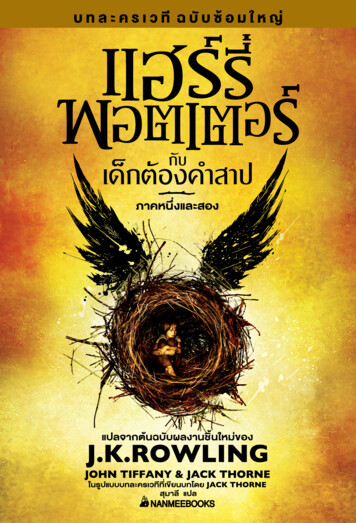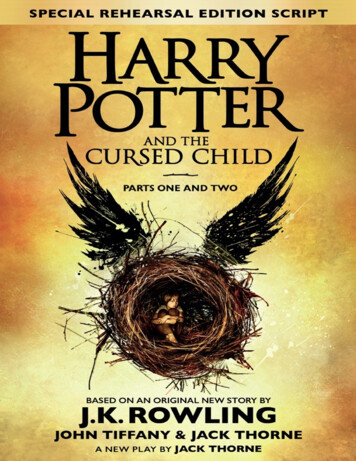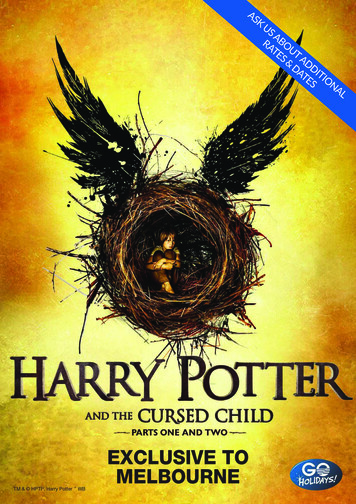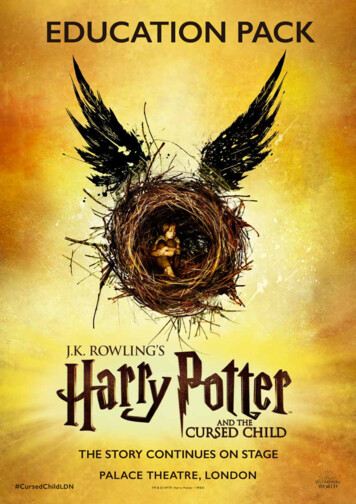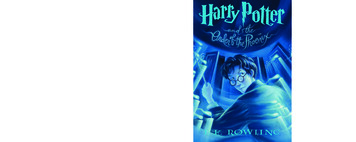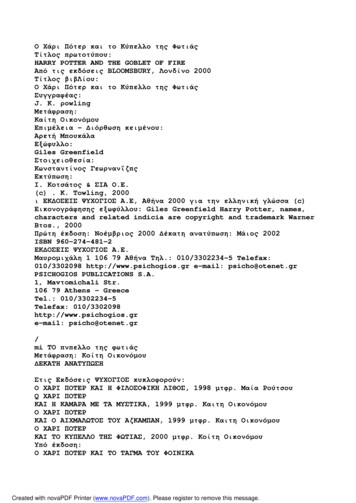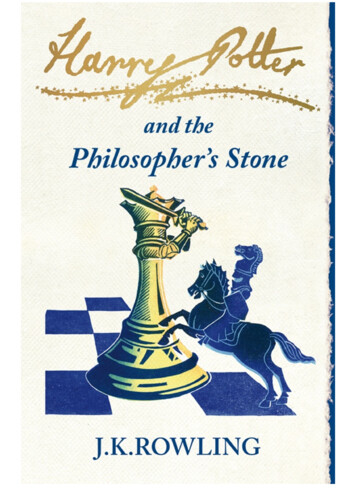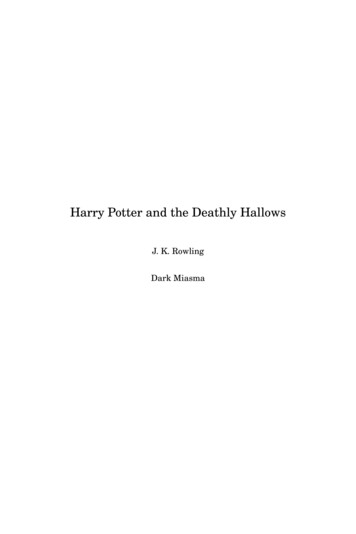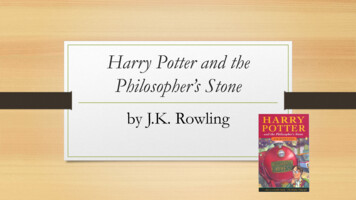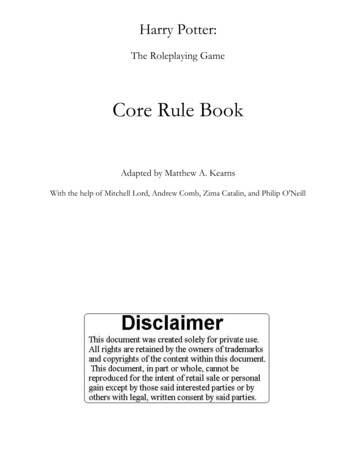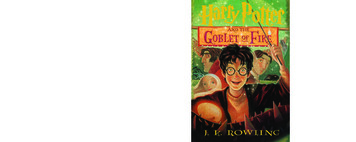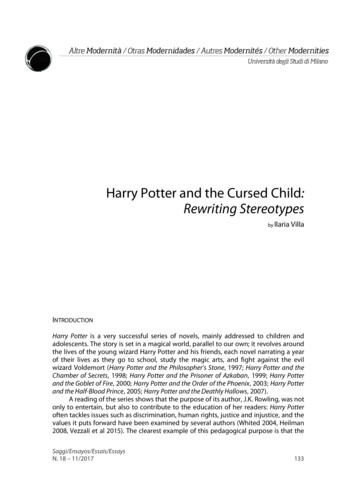
Transcription
Harry Potter and the Cursed Child:Rewriting Stereotypesby IlariaVillaINTRODUCTIONHarry Potter is a very successful series of novels, mainly addressed to children andadolescents. The story is set in a magical world, parallel to our own; it revolves aroundthe lives of the young wizard Harry Potter and his friends, each novel narrating a yearof their lives as they go to school, study the magic arts, and fight against the evilwizard Voldemort (Harry Potter and the Philosopher’s Stone, 1997; Harry Potter and theChamber of Secrets, 1998; Harry Potter and the Prisoner of Azkaban, 1999; Harry Potterand the Goblet of Fire, 2000; Harry Potter and the Order of the Phoenix, 2003; Harry Potterand the Half-Blood Prince, 2005; Harry Potter and the Deathly Hallows, 2007).A reading of the series shows that the purpose of its author, J.K. Rowling, was notonly to entertain, but also to contribute to the education of her readers: Harry Potteroften tackles issues such as discrimination, human rights, justice and injustice, and thevalues it puts forward have been examined by several authors (Whited 2004, Heilman2008, Vezzali et al 2015). The clearest example of this pedagogical purpose is that theSaggi/Ensayos/Essais/EssaysN. 18 – 11/2017133
main villains of the story are wizards and witches who discriminate between peoplewho are endowed with magical powers and people who are not (‘Muggles’), and whothink that only those who come from ancient magical families should be granted amagical education. Those who stand on the right side, on the contrary, fight for theequality of all human beings. Another level of discrimination in the story is thatbetween human and non-human magic people, such as elves, goblins, centaurs,giants, and werewolves, which are often treated as inferior by humans: for this reason,the main characters often discuss the problems and the contradictions of the worldthey live in. In fact, in some cases, even positive characters have to challenge their ownprejudices.1Moreover, an issue which is brought to the attention of the readers is that peopleare often more complex than what they look like and are not easy to label as ‘good’ or‘evil’: as the story develops, the reader is provided with more information about somecharacters and is often led to reconsider his/her initial opinion on them. This happens,for instance, in the case of professor Snape, an unfair teacher and unpleasant person,who is believed to be a dark wizard until, after his death, it is revealed that he was anexcellent spy who fought for the good side. Another example is the characterisation ofHarry Potter’s father, James Potter. Since both Harry’s parents were killed byVoldemort when Harry was one year old, Harry’s knowledge of his parents is based onwhat their old friends tell him. James Potter is usually described as a brave and goodhearted person; therefore, Harry looks up to him and is honoured whenever someonetells him that he is similar to his father. In Harry Potter and the Order of the Phoenix,however, Harry finds out that James was a bully in his school years. This is the momentwhen Harry has to accept that flawless heroes do not exist; he has to recognise that hisfather’s behaviour was wrong and, at the same time, he has to understand that even abully can grow up, change and become a better person.It must be said that the real villains of the story, that is to say Voldermort and hisacolytes (the “Death Eaters”) 2, are absolutely and permanently evil, as the plot is basedon the classical literary scheme of the fight between good and evil. However, thecharacterisation of many of the main and secondary characters is realistic and worthyof attention. The protagonists also evolve throughout the books (which, in theirentirety, can certainly be considered a Bildungsroman), growing up, recognising theirflaws and their mistakes, becoming wiser and more mature.1See, for example, the initial horrified reaction of Ron, Harry’s best friend and thus a positivecharacter, when he finds out that one of the kindest and most competent of their teachers, RemusLupin, is a werewolf (Prisoner of Azkaban, 253). Lupin’s condition makes it almost impossible for him tofind a job in the wizarding world, even if he has actually never harmed a human being: his situationmirrors the stigmatisation of some groups of people in the real world, such as, for example, people withAIDS. Another interesting example, this time of introjected discrimination, is that of house-elves, whowork without payment for wizards and witches and who are for the most part convinced that they likebeing enslaved (for an analysis of slavery and ethics in Harry Potter, see Patterson 2004).2Death Eaters are dark wizards, the closest to Voldemort and the more dangerous among hisfollowers, who want to take control of the magical society to enforce the aforementioned discriminationbetween ancient magical families and the rest of the people.Saggi/Ensayos/Essais/EssaysN. 18 – 11/2017134
THE SLYTHERIN ISSUE, ‘GOOD’ VS. ‘EVIL’Despite the careful construction of themes and characters, some stereotypes in HarryPotter simply remain stereotypes up to the very end: the most obvious case is that ofthe house of Slytherin. Hogwarts, the British wizarding school, is organised in a waywhich mirrors real British boarding schools;3 one of the mutual characteristics betweenHogwarts and boarding schools is the presence of different houses into whichstudents are divided. The magical element of Hogwarts, in this case, is that first-yearstudents are examined by a mind-reading hat, which sorts them into the fourHogwarts houses on the basis of their personality: Gryffindor is for the brave andchivalrous, Hufflepuff for the just, loyal and hard-working, Ravenclaw for the wise andclever, Slytherin for the cunning and ambitious. During each school year, house pointsare given to students as a reward either for their behaviour or for their participation inclass; on the opposite, points can be taken from houses as a punishment. At the end ofeach school year, the house with the most points wins the House Cup, and this createscompetition and rivalry among the houses. However, people are not onlycharacterised by the personality tracts typical of their own house, but they appear tobe either ‘good’ or ‘evil’ depending on which house they belong to. It is said manytimes that Slytherin is the house of most of the dark wizards: Voldemort himself, thesupervillain, was a Slytherin when he was a student, and his inner circle of Death Eatersis all made of Slytherins. The problem, of course, is that students are sorted into one ofthe four houses on their first day of school, at the age of eleven, and their house neverchanges. In this way, the reader is automatically led to perceive the group of Slytherinstudents as villains or at least future villains, as if their personality were already settledand there were few possibilities for them to ‘redeem’ themselves. Also, most of thepeople (both young and adult) fighting against Voldemort belong to Gryffindor:therefore, Gryffindor’s reputation in the story is that of the best house of all, the houseof the leaders of the good side, whereas the other two houses seem almost negligible.This strong opposition between the ‘good’ and the ‘evil’ house is already presentin the first book, Harry Potter and the Philosopher’s Stone, in which the people Harrymeets before going to Hogwarts seem to consider houses as ranging from the bestone to the worst one in general: no one seems to care about the fact that each personshould, in theory, have their own best house, that is to say the one which suits thembest. The arrogant Draco Malfoy, an obvious antagonist, tells Harry “Well, no one reallyknows until they get there, do they, but I know I’ll be in Slytherin, all our family havebeen – imagine being in Hufflepuff, I think I’d leave, wouldn’t you?” (Philosopher’sStone, 88); Rubeus Hagrid’s remark when Harry asks his opinion is “Better Hufflepuffthan Slytherin [.] There’s not a single witch or wizard who went bad who wasn’t inSlytherin” (90); and even Hermione Granger, who is Muggle-born (born in a nonmagical family), has already conformed to the general feeling towards houses: “I’ve3For an analysis of this resemblance between Hogwarts and boarding schools, see Iyer (1999)and Steege (2004).Saggi/Ensayos/Essais/EssaysN. 18 – 11/2017135
been asking around and I hope I’m in Gryffindor, it sounds by far the best, I hearDumbledore himself was one, but I suppose Ravenclaw wouldn’t be too bad” (117).Hermione’s position is even more peculiar if we consider that she immediately standsout as the most brilliant at school (147, 187), which is a Ravenclaw quality; she is alsoambitious (150, 170), very respectful of rules (162, 170-177) and hard-working(Chamber of Secrets, 272), whereas she only proves her courage from the end of thefirst novel onwards.The reader might think that the initial prejudice towards Slytherin will bechallenged at some point in the story, as it happens many times with the prejudicesagainst non-human and semi-human races; however, this never seems to happen.Most of the Slytherin students we meet are children of Death Eaters; the others arearrogant and aggressive or are simply not described. The Slytherin Quidditch team4when playing behaves in an unfair way (Philosopher’s Stone, 204, 207, Chamber ofSecrets, 122) and is hated by all the other three houses (183). In the second book, HarryPotter and the Chamber of Secrets, a recurrent theme is Harry’s fear that he may havebeen put in the wrong house and that he could actually belong to Slytherin (214, 224):this fear is dispelled when Harry proves to be a true Gryffindor by means of a symbolicact, that of being able to find and use Gryffindor’s sword (358). At the end of the novelDumbledore himself assures Harry that he is a Gryffindor, because he chose to be one(“It is our choices, Harry, that show what we truly are, far more than our abilities”, ibid.),and he does not feel the need to make clear that Harry would still be a good personeven if he had been placed in Slytherin.The portrayal of Slytherin students does not change in later books: in Harry Potterand the Order of the Phoenix, for example, Hogwarts is ruled by a wicked and racistmember of the Minister for Magic, who limits the students’ freedom and creates an“Inquisitorial Squad” to control them. Needless to say, the squad is formed by Slytherinstudents. Even in the last novel, when Hogwarts is in the hands of the evil DeathEaters, Rowling uses these words to describe a secret room where the leaders of thestudents’ resistance have gone into hiding: “Harry saw the gold Gryffindor lion,emblazoned on scarlet; the black badger of Hufflepuff, set against yellow, and thebronze eagle of Ravenclaw, on blue. The silver and green of Slytherin alone wereabsent” (Deathly Hallows, 464-465). The fact that the whole of Slytherin house, and notjust some of its students, belongs to the ‘dark side’ is confirmed one last time at thebeginning of the final battle between the good and the evil forces, which takes placeat Hogwarts. Before the battle starts, professor McGonagall, a beloved teacher and avery good fighter, arranges for the evacuation of the students from the school, butallows students of age to stay and fight against Voldemort if they want to; however,she invites the house of Slytherin in its entirety to leave (489-491).The only attempt to redeem Slytherin’s reputation may be found in the epilogue,which takes place nineteen years after the final battle. Harry Potter and his friends are4Quidditch is the favourite sport of witches and wizards and is played on broomsticks. AtHogwarts, each house has its own Quidditch team, which plays against the other teams in the . 18 – 11/2017136
now happy and married, and their children are about to begin their school year atHogwarts. Harry’s second son is worried that he may be placed into Slytherin andHarry reassures him:“Albus Severus, [.] you were named for two headmasters of Hogwarts. One ofthem was a Slytherin and he was probably the bravest man I ever knew.”5“But just say–”“– then Slytherin house will have gained an excellent student, won’t it? It doesn’tmatter to us, Al. But if it matters to you, you’ll be able to choose Gryffindor overSlytherin. The Sorting Hat takes your choice into account.” (607)Harry’s speech shows that he does not care about house belonging anymore;however, he still implies that his son’s choice, if given the possibility, would beGryffindor – not Slytherin and not one of the other two houses, Hufflepuff andRavenclaw, which are unrepresented here as they are most of the time throughout thestory.The reason behind the portrayal of Slytherins as the permanent antagonists is, ofcourse, a narrative one. In the Harry Potter novels, the young protagonists do not onlyhave to fight Voldemort and his Death Eaters, who threaten to conquer the magicalworld, but they also go through a series of minor adventures at school, where theyhave to face minor antagonists: Slytherin bullies and some unfair (or even dangerous)teachers. The choice to portray such negative young characters is thusunderstandable; however, since the educational purpose of the novels is clear, thereader would expect the author to challenge, at some point, the implication that aquarter of the Hogwarts students is already evil at the age of eleven and that none ofthese students would ever fight for the good side.As for Rowling’s position regarding the way in which she described Slytherinstudents, she stated in an interview that “they’re not all bad. [.] Death Eaters’ children[.] are a small fraction of the total Slytherin population. I’m not saying all the otherSlytherins are adorable” (Hawk 2005). Quite interestingly, she also declared “A part ofthe final battle that made me smile was Slughorn galloping back with Slytherins”(Anelli 2008). Slughorn is a teacher and a Slytherin; he is indeed described as leadingthe reinforcements during the final battle. However, he is said to have come back tofight together with the friends and families of the students who are already fighting(Deathly Hallows, 588): no Slytherin student fighting against Voldemort seems to bementioned in the final book, not even at professor Slughorn’s side. This means thatRowling ‘knows’ that, in her universe, some Slytherins have come back to help, butthat she did not consider this detail important enough to check if she had explicitlydescribed Slytherin fighters. Also, many Harry Potter readers may never challenge theirown ideas about Slytherin, ideas coming, of course, from the way this house has beendescribed in the novels, if they do not come across the author’s interviews.5Severus Snape is the war hero mentioned above; even though he is the ‘good example’ Harryuses to reassure his son, Snape was a dark wizard in his youth and is constantly described as an unfairteacher at Hogwarts (Philosopher’s Stone, 150-153, Chamber of Secrets, 207-210).Saggi/Ensayos/Essais/EssaysN. 18 – 11/2017137
SLYTHERIN IN FANFICTIONSThe Slytherin issue may seem an issue of minor importance: after all, any young readerneeds heroes to identify with and villains to despise. It would also be impossible toimagine she school of Hogwarts without divisions of any sort, because housebelonging is a relevant element in the plot of all seven novels. In fact, Rowling’s idea tocreate four houses based on four main personality types was undoubtedly a success,as the amount of house-themed Harry Potter gadgets suggests: Harry Potter fans donot only dream of attending Hogwarts, but they usually imagine which house theywould be in, and this sense of belonging creates an emotional attachment to the saga.However, this is precisely one of the reasons why the portrayal of Slytherins mayactually be a major issue: since ambitious people do exist, it is inevitable that somereaders identify with the personality features of the house of Slytherin; therefore, thesereaders may feel that ‘their’ house has not been given a fair treatment in the books.It should be added that many fans have been ‘officially sorted’ into Slytherinwhen, after the publication of the seven novels, Rowling created “Pottermore”(launched in 2011 as a beta version and in 2015 in a renovated version). “Pottermore”is an interactive website with all kinds of information and special contents about theHarry Potter world, where people can register and take tests to find out which wandsuits them best, which is their guardian animal (the “Patronus”) and, of course, whichhouse they belong to. With a part of the fans actually labelled as Slytherins, their nowofficial house obviously needed to be given a better reputation. In fact, some attemptshave been made on the “Pottermore” website itself. In the section “Features”, forexample, we can find several articles trying to shed a positive light on Slytherin, suchas Why Hogwarts needs Slytherin house or 5 reasons why you should find yourself aSlytherin BFF [best friend forever]. These, however, are simply online articles: a literaryanswer to the Slytherin issue was probably needed.In order to have a better awareness of the reactions and feelings of Harry Potterreaders, it could be useful to look at the stories descending from the Harry Potter lorewhich have been written by the fans themselves, the so-called ‘fanfictions’. The HarryPotter saga is probably the story on which the largest number of fanfictions have beenwritten and published online: if we look at the most well-known fanfiction website,“FanFiction”, we can see that the stories based on the Harry Potter novels alone are766,000 (May 2017), more than those of any other ‘fandom’ (or narrative universe) on“FanFiction”. Harry Potter is also one of the fandoms with the most fanfictions on thewebsite “Archive of Our Own”, with 134,408 stories so far. The reason for theflourishing of fanfictions on the Harry Potter world is certainly the great success, interms of readers and audience, of both the novels and the films of the saga. It couldalso be said that, since the plot develops over various generations, in a parallel worldwith its own traditions, customs and history, with a vast number of characters, many ofwhom are only mentioned or are not completely explored in the novels, the story initself is particularly fit for rewritings and expansions, as any reader would like toSaggi/Ensayos/Essais/EssaysN. 18 – 11/2017138
imagine additional episodes in the lives of the main Harry Potter characters, to giveshape to the characters which stand in the background and which are not developedor even to create brand new characters belonging to the Harry Potter universe.Many of these fanfictions available on the internet talk about Slytherincharacters: if we search for the word ‘Slytherin’ among the titles and summaries of allthe fanfictions on Harry Potter on the website “FanFiction”, we find the impressivenumber of 15,218 stories (May 2017). The search for the names of the other houses intitles and summaries yields very different results: 9416 for ‘Gryffindor’, 3028 for‘Ravenclaw’ and 2184 for ‘Hufflepuff’. The same experiment can be repeated for theother large fanfiction website already mentioned here, Archive of Our Own. On thislatter website, the stories of the Harry Potter fandom with the word ‘Slytherin’ in thetitle, summary or notes are 4740, significantly more than the ones in which the word‘Gryffindor’ appears (2847). Again, the search for ‘Ravenclaw’ and ‘Hufflepuff’ gives thelowest numbers as a result (1635 and 1527 respectively). Another search which can beconducted on the website Archive of Our Own is a search by means of the ‘tag’, that is alabel used by fanfiction authors to catalogue their stories, so that readers are able tofind stories about particular topics: quite interestingly, a tag which has sometimesbeen used by these amateur writers is ‘Good Slytherins’, with 205 stories labelled assuch.These numbers suggest that Harry Potter fans are interested in writing andreading stories about Slytherin characters – perhaps more interested than they are inwriting and reading stories concerning the other three houses, including Gryffindor,the house to which the Harry Potter protagonists belong. Some fans, in particular,apparently need to write and read stories in which the cunning Slytherins can bebrave, loyal and clever just as much as the students of the other houses. This interest inthe portrayal of characters belonging to what is traditionally known as the ‘evil house’could be one of the reasons why the play Harry Potter and the Cursed Child was written.THE PLAY BY THORNE, AND THE HOUSE OF SLYTHERIN THEREINHarry Potter and the Cursed Child was first staged in 2016 in two parts and thenpublished as a book in the same year. The play, “based on an original new story by J. K.Rowling, Jack Thorne & John Tiffany”, as the cover of the book states, was written byThorne and directed by Tiffany: since Rowling is not the actual writer nor the mainauthor of this work, as she merely contributed – we don’t know in which way – to thecreation of the plot, Harry Potter and the Cursed Child may be considered as a sort of‘official fanfiction’. It could be added that the play was staged nine years after thepublication of the last Harry Potter novel, therefore it was obviously not included in theauthor’s original plan.The protagonist of the play is Albus Severus Potter, the second of Harry’s threechildren and the central character in the epilogue of Harry Potter and the DeathlyHallows. In fact, the play begins by recreating the epilogue of the novels and changingit slightly:Saggi/Ensayos/Essais/EssaysN. 18 – 11/2017139
ALBUS pulls on HARRY’s robes. HARRY looks down. Do you think – what if I am –what if I’m put in Slytherin.HARRY And what would be wrong with that?ALBUS Slytherin is the house of the snake, of Dark Magic. it’s not a house of bravewizards.HARRY Albus Severus, you were named after two headmasters of Hogwarts. Oneof them was a Slytherin and he was probably the bravest man I ever knew.ALBUS But just say.HARRY If it matters to you, you, the Sorting Hat will take your feelings intoaccount.ALBUS Really?HARRY It did for me. (Cursed Child, 9-10)Interestingly, Harry’s remaining bias in favour of Gryffindor is here wiped out: inthis scene, Harry does not say “you’ll be able to choose Gryffindor over Slytherin”, as inHarry Potter and the Deathly Hallows, but he is more ‘politically correct’ and simplyrefers to Albus’s feelings. Therefore, the audience’s (and the readers’) initial perceptionis that there is nothing wrong with being sorted into Slytherin and that a good personmight belong to any house: this will make them perceive the injustice of the otherstudents’ behaviour when, later that day, Albus will actually be sorted into Slytherin.On the train to Hogwarts, Albus meets Scorpius Malfoy, son of Harry’s oldantagonist at school, Draco. Scorpius is a very nice person and Albus gladly remains inhis train compartment during the journey; however, Albus’s cousin, Rose GrangerWeasley, who is also starting her first year at Hogwarts, has already labelled Scorpius as‘wrong company’, because his father was once on Voldemort’s side and because thereis a false rumour about Scorpius being Voldemort’s son. For these reasons, Rose doesnot even want to come to know Scorpius; she does not feel the need to be polite withhim, nor does she hide her dislike for him. Scorpius, on the other hand, remains verykind despite Rose’s behaviour (15-16): in this way, she is shown to be the prejudicedone, while the audience is led sympathise with Scorpius, who must bear the burden ofbeing Draco’s son.During the Sorting ceremony at Hogwarts, Rose is placed into Gryffindor andScorpius into Slytherin. Albus is placed into Slytherin as well and we know right awaythat the prejudice towards that house has not changed. When Albus is sorted, theother students’ astonishment is underlined by Rose’s words: “this is wrong, Albus” (21).Then, with a few quick time shifts, we see that Albus is not at all good at Quidditch (hisfather, on the contrary, was an excellent Quidditch player), that the other students –and even his own brother, James – have begun to make fun of him, that one year laterhe and Rose have stopped speaking to each other, that being seen in public with Harrymakes him uncomfortable:HARRY It’s just people looking okay? People look. And they’re looking at me, notyou. [.]ALBUS At Harry Potter and his disappointing son.Saggi/Ensayos/Essais/EssaysN. 18 – 11/2017140
HARRY What does that mean?ALBUS At Harry Potter and his Slytherin son.JAMES Slythering Slytherin, stop with your dithering, time to get on to the train.(23)Rose, on the other hand, is the exact contrary of his cousin. She is a Gryffindor aseveryone expected, she is successful in both school subjects and Quidditch, and theonly thing which worries her seems to be “whether she’ll break the Quidditch scoringrecord in her first or second year. And how early she can take her O.W.L.s [her fifth-yearexams]” (11).When Albus, Scorpius and Rose begin their third year, Lily, the last of the Potterchildren, is sorted into Gryffindor and Albus is disappointed. Scorpius says to him “Didyou really think she’d come to us? Potters don’t belong in Slytherin” and Albus proudlyanswers “This one does” (Ibid.: 29). Here, for the first time in the Harry Potter universe(the official one, of course), the protagonist and hero, an outcast who can arouse theaudience’s sympathy, is a Slytherin, as is his best friend, Scorpius, who is kind, funnyand good-hearted, whereas Gryffindors are just background characters. TheGryffindor-Slytherin relationship is also completely reversed: in the Harry Potter novels,the Slytherin students – and Draco Malfoy in particular – are the bullies and theGryffindor protagonists have to face their taunting, whereas in Harry Potter and theCursed Child the protagonists’ lives at Hogwarts are difficult exactly because they areSlytherins. Albus and Scorpius are teased, even bullied, because people makeassumptions based on their family – in the case of Scorpius – or because they do notconform with what is expected from them – in the case of Albus:SCORPIUS [.] You know how I like to. get on early. Stops people staring.Shouting. Writing ‘son of Voldemort’ on my trunk. That one never gets old. (55)ALBUS [.] As he tries to melt into the background, the other students laugh. He looksup at them all. I didn’t choose, you know that? I didn’t choose to be his son. (29)The Gryffindor young characters of the play, on the contrary, are popular andhappy; they do not seem to care about the fact that Albus and Scorpius have nofriends except each other, and James, in particular, teases his own brother justbecause of the house he belongs to.Later in the play, when Albus and Scorpius steal a Time-Turner (a very raremagical object that can be used to travel through time) to try to save a boy who diedmany years before, they accidentally create an alternative universe where Rose doesnot exist because her father, Ron, did not marry Hermione but another classmate,Padma Patil. Albus and Scorpius find out that in this reality Albus is a Gryffindor;however, he still does not have a ‘Gryffindor personality’, but, as we are informed, hepersuaded the Sorting Hat to place him into that house just to spite Ron and Padma’sson, Panju, who made fun of him and challenged him by saying that he could notpossibly be sorted in Gryffindor (129). The implication is, again, that in any universeAlbus should be a Slytherin and that Gryffindors laugh at him because he is different.Saggi/Ensayos/Essais/EssaysN. 18 – 11/2017141
In fact, even though Albus officially belongs to Gryffindor in the alternative universe,he does not like his house at all and his best friend is still Scorpius, a Slytherin.The fact that Albus is not at all like his siblings and cousins also creates tensionbetween him and Harry; their difficult relationship is in fact one of the main themes ofthe play. Interestingly, in the alternative universe where Albus has been placed intoGryffindor his relationship with his father is just as complicated as it is in the ‘normal’universe: even though Albus sees this as a demonstration of the fact that theirproblems do not depend on the house he belongs to (219), it could be remarked thatin the alternative universe Albus still hates Gryffindor house (135). In other words, hispersonality does not change and he remains an outcast in any context. This meansthat the fact that Albus is a Slytherin is not the cause of his problems, but just a way tounderline his uniqueness in a family of Gryffindors and, in general, his being, as alreadysaid, ‘different’. In the end, however, the tension between Harry and Albus makesAlbus the most interesting of the Potter children: when father and son finally reconcile,after a tragic battle back in time in which the main characters witnessed the murder ofHarry’s parents, Harry reveals to Albus that the two of them are quite similar and that iswhy their relationship is not easy.HARRY [.] I’m going to try with everything I’ve got – to be a good dad for you.ALBUS And I’ll try and be a better son. I know I’m not James, Dad, I’ll never be likeyou two–HARRY James is nothing like me. [.] Everything comes easy for James. Mychildhood was a constant struggle.ALBUS So was mine. So you’re saying – am I – like you?HARRY smiles at ALBUS.HARRY Actually you’re more like your mum – bold, fierce, funny – which I like –which I think makes you a pretty great son. (327-328)If Albus is indeed the most interesting among Harry’s children, this is alsobecause his siblings are not given much space, as it happens with most of the youngcharacters in the play, except for Albus himself and for his best friend Scorpius. In fact,it would
Harry Potter and the Cursed Child: Rewriting Stereotypes by Ilaria Villa INTRODUCTION Harry Potter is a very successful series of novels, mainly addressed to children and adolescents. The story is set in a magical world, parallel to our own; it revolves around the lives of the young wizard Harry Pot
